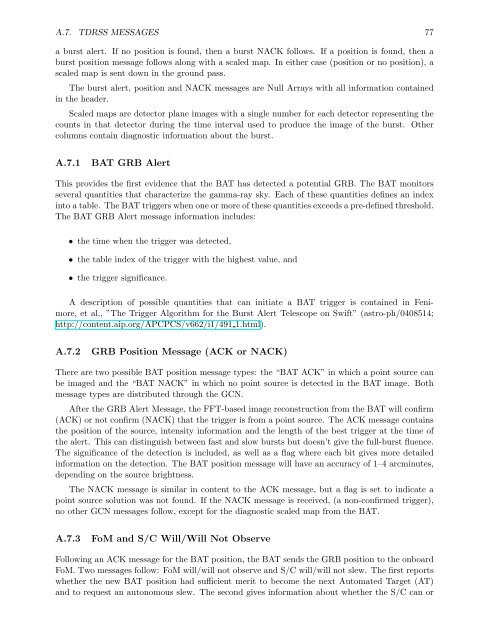The SWIFT BAT Software Guide Version 6.3 30 ... - HEASARC - Nasa
The SWIFT BAT Software Guide Version 6.3 30 ... - HEASARC - Nasa
The SWIFT BAT Software Guide Version 6.3 30 ... - HEASARC - Nasa
You also want an ePaper? Increase the reach of your titles
YUMPU automatically turns print PDFs into web optimized ePapers that Google loves.
A.7. TDRSS MESSAGES 77<br />
a burst alert. If no position is found, then a burst NACK follows. If a position is found, then a<br />
burst position message follows along with a scaled map. In either case (position or no position), a<br />
scaled map is sent down in the ground pass.<br />
<strong>The</strong> burst alert, position and NACK messages are Null Arrays with all information contained<br />
in the header.<br />
Scaled maps are detector plane images with a single number for each detector representing the<br />
counts in that detector during the time interval used to produce the image of the burst. Other<br />
columns contain diagnostic information about the burst.<br />
A.7.1 <strong>BAT</strong> GRB Alert<br />
This provides the first evidence that the <strong>BAT</strong> has detected a potential GRB. <strong>The</strong> <strong>BAT</strong> monitors<br />
several quantities that characterize the gamma-ray sky. Each of these quantities defines an index<br />
into a table. <strong>The</strong> <strong>BAT</strong> triggers when one or more of these quantities exceeds a pre-defined threshold.<br />
<strong>The</strong> <strong>BAT</strong> GRB Alert message information includes:<br />
• the time when the trigger was detected,<br />
• the table index of the trigger with the highest value, and<br />
• the trigger significance.<br />
A description of possible quantities that can initiate a <strong>BAT</strong> trigger is contained in Fenimore,<br />
et al., ”<strong>The</strong> Trigger Algorithm for the Burst Alert Telescope on Swift” (astro-ph/0408514;<br />
http://content.aip.org/APCPCS/v662/i1/491 1.html).<br />
A.7.2 GRB Position Message (ACK or NACK)<br />
<strong>The</strong>re are two possible <strong>BAT</strong> position message types: the “<strong>BAT</strong> ACK” in which a point source can<br />
be imaged and the “<strong>BAT</strong> NACK” in which no point source is detected in the <strong>BAT</strong> image. Both<br />
message types are distributed through the GCN.<br />
After the GRB Alert Message, the FFT-based image reconstruction from the <strong>BAT</strong> will confirm<br />
(ACK) or not confirm (NACK) that the trigger is from a point source. <strong>The</strong> ACK message contains<br />
the position of the source, intensity information and the length of the best trigger at the time of<br />
the alert. This can distinguish between fast and slow bursts but doesn’t give the full-burst fluence.<br />
<strong>The</strong> significance of the detection is included, as well as a flag where each bit gives more detailed<br />
information on the detection. <strong>The</strong> <strong>BAT</strong> position message will have an accuracy of 1–4 arcminutes,<br />
depending on the source brightness.<br />
<strong>The</strong> NACK message is similar in content to the ACK message, but a flag is set to indicate a<br />
point source solution was not found. If the NACK message is received, (a non-confirmed trigger),<br />
no other GCN messages follow, except for the diagnostic scaled map from the <strong>BAT</strong>.<br />
A.7.3 FoM and S/C Will/Will Not Observe<br />
Following an ACK message for the <strong>BAT</strong> position, the <strong>BAT</strong> sends the GRB position to the onboard<br />
FoM. Two messages follow: FoM will/will not observe and S/C will/will not slew. <strong>The</strong> first reports<br />
whether the new <strong>BAT</strong> position had sufficient merit to become the next Automated Target (AT)<br />
and to request an autonomous slew. <strong>The</strong> second gives information about whether the S/C can or


